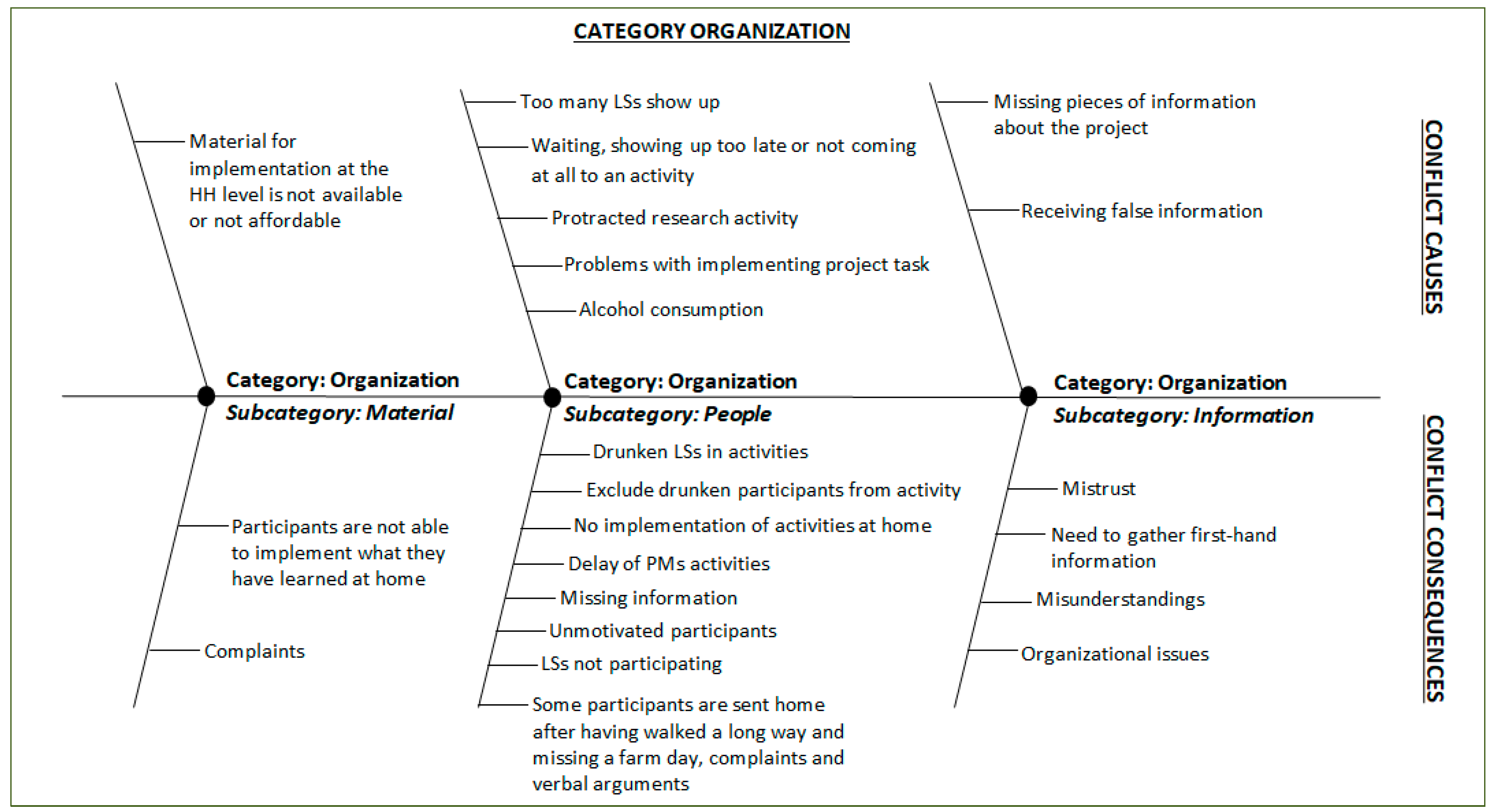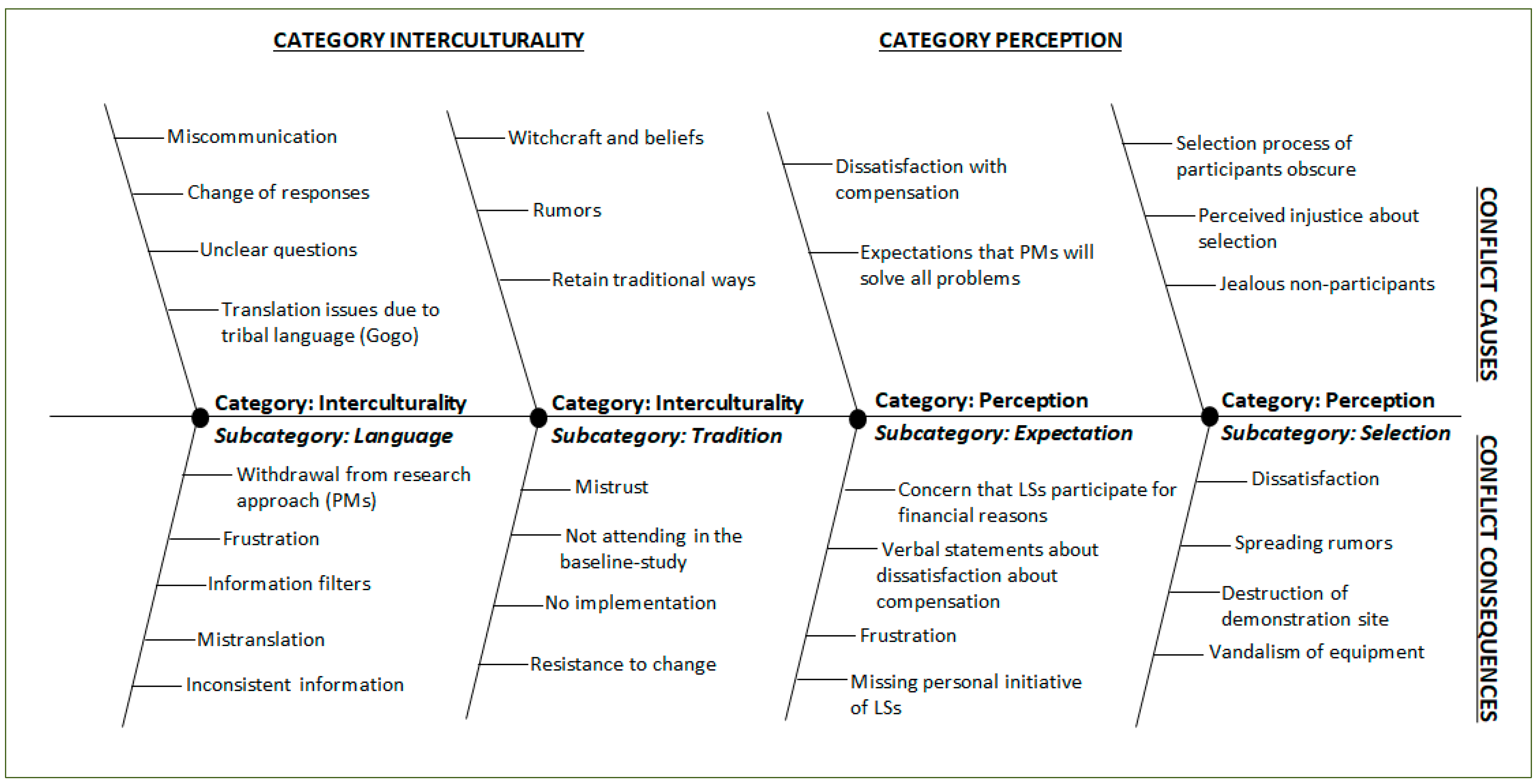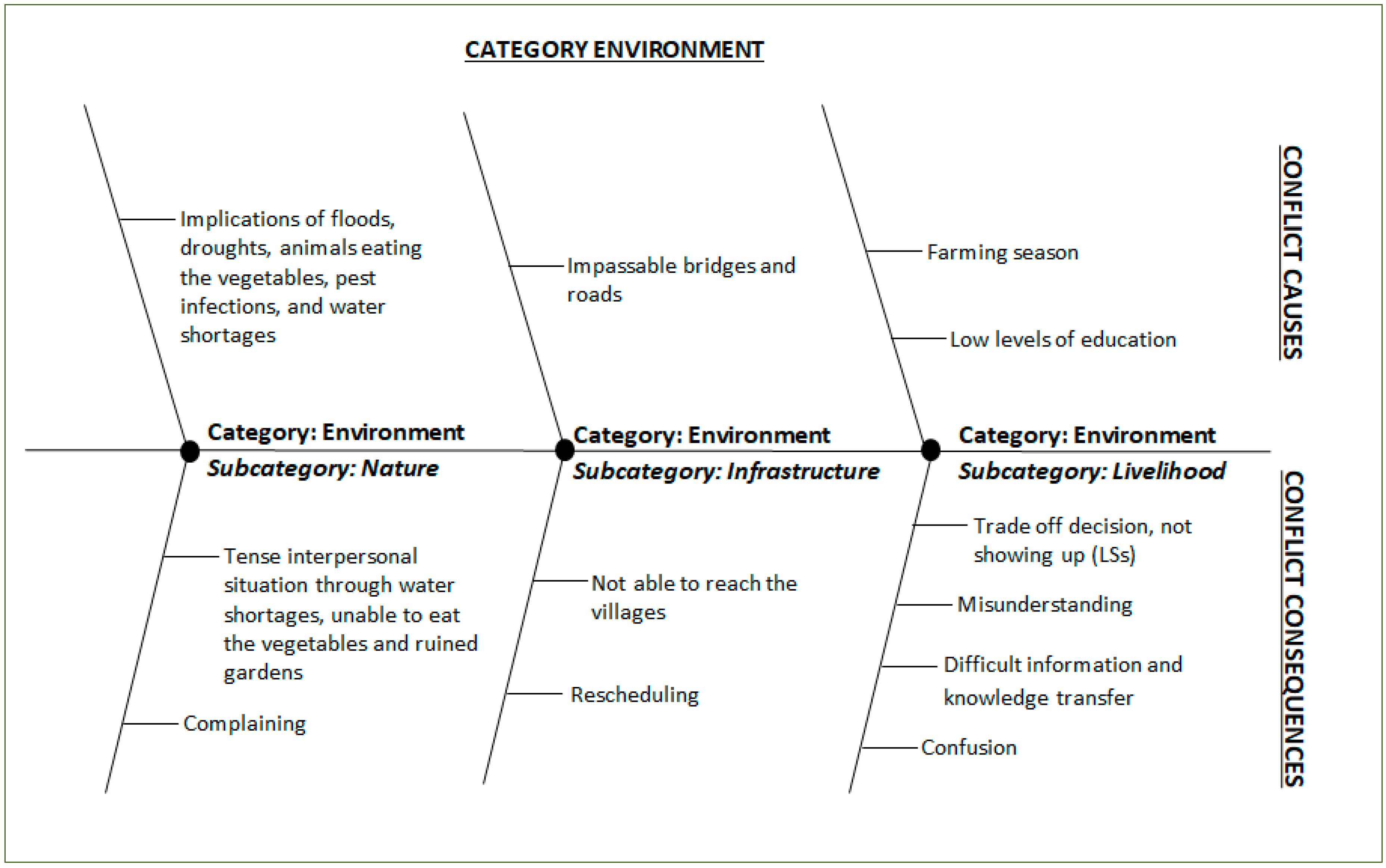Conflict Causes and Prevention Strategies at the Society-Science Nexus in Transdisciplinary Collaborative Research Settings: A Case Study of a Food Security Project in Tanzania
Abstract
1. Introduction
2. Conflict Drivers and Prevention Strategies
3. Materials and Methods
3.1. Case Study Description
3.2. Methods
3.2.1. Personal Interviews
3.2.2. Focus Group Discussions
3.3. Analytical Approach
4. Results
4.1. Conflict Causes at the LS–PM Collaboration Intersection
4.1.1. Category: Organization
4.1.2. Category: Interculturality
4.1.3. Category: Perception
4.1.4. Category: Environment
4.2. Identified Strategies that Prevented Conflict
4.2.1. Involvement of Locals
4.2.2. Development of Trust
4.2.3. Reducing the Language Barrier
5. Discussion
Prevention Strategies of Conflict Causes
6. Conclusions
Author Contributions
Funding
Acknowledgments
Conflicts of Interest
References
- IPCC. Summary for Policymakers. In Climate Change 2013: The Physical Science Basis; Contribution of Working Group I to the Fifth Assessment Report of the Intergovernmental Panel on Climate Change; Stocker, T.F., Qin, D., Plattner, G.-K., Tignor, M., Allen, S.K., Boschung, J., Nauels, A., Xia, Y., Bex, V., Midgley, P.M., Eds.; Cambridge University Press: Cambridge, UK; New York, NY, USA, 2013. [Google Scholar]
- IPCC. Summary for Policymakers. In Climate Change 2014: Impacts, Adaptation, and Vulnerability, Part A: Global and Sectoral Aspects; Contribution of Working Group II to the Fifth Assessment Report of the Intergovernmental Panel on Climate Change; Field, C.B., Barros, V.R., Dokken, D.J., Mach, K.J., Mastrandrea, M.D., Bilir, T.E., Chatterjee, M., Ebi, K.L., Estrada, Y.O., Genova, R.C., et al., Eds.; Cambridge University Press: Cambridge, UK; New York, NY, USA, 2014. [Google Scholar]
- United Nations. The Millennium Development Goals Report 2015; United Nations: New York, NY, USA, 2015. [Google Scholar]
- Todaro, M.P.; Smith, S.C. Economic Development, 12th ed.; Pearson: London, UK, 2015. [Google Scholar]
- United Nations Framework Convention on Climate Change (UNFCCC). Elements of Adaptation. 2014. Available online: http://unfccc.int/focus/adaptation/items/6999.php (accessed on 5 November 2018).
- Mohtar, H.R.; Lawford, R. Present and future of the water-energy-food nexus and the role of the community of practice. J. Environ. Stud. Sci. 2016, 6, 192–199. [Google Scholar] [CrossRef]
- Mauser, W.; Klepper, G.; Rice, M.; Schmalzbauer, B.S.; Hackmann, H.; Leemans, R.; Moore, H. Transdisciplinary global change research: The co-creation of knowledge for sustainability. Curr. Opin. Environ. Sustain. 2013, 5, 420–431. [Google Scholar] [CrossRef]
- Löhr, K.; Graef, F.; Bonatti, M.; Mahoo, H.F.; Wambura, J.; Sieber, S. Conflict management systems for large scientific research projects. Int. J. Confl. Manag. 2017, 28, 322–345. [Google Scholar] [CrossRef]
- Daher, B.; Mohtar, R.H.; Pistikopoulos, E.N.; Portney, K.E.; Kaiser, R.; Saad, W. Developing Socio-Techno-Economic-Political (STEP) Solutions for Addressing Resource Nexus Hotspots. Sustainability 2018, 10, 512. [Google Scholar] [CrossRef]
- Larrison, C.R. A Comparison of Top-down and Bottom-up Community Development Interventions in Rural Mexico: Practical and Theoretical Implications for Community Development Programs. University of Georgia, 1999. Available online: https://kb.osu.edu/dspace/bitstream/handle/1811/36912/l12larrison-paper.pdf?sequence=1 (accessed on 16 September 2019).
- Ross, L.F.; Loup, A.; Nelson, R.M.; Botkin, J.R.; Kost, R.; Smith, G.R.; Gehlert, S. The Challenges of Collaboration for Academic and Community Partners in a Research Partnership: Points to Consider. J. Empir. Res. Hum. Res. Ethics 2010, 5, 19–31. [Google Scholar] [CrossRef] [PubMed]
- Moura, H.; Teixeira, J.C. Managing Stakeholders Conflicts; Wiley Online Library: Hoboken, NJ, USA, 2010; Chapter 17. [Google Scholar] [CrossRef]
- Löhr, K.; Weinhardt, M.; Schütt, J.; Bonatti, M.; Graef, F.; Sieber, S. Transdisciplinary research in sustainable development projects: analyzing collaboration experience at the society-science nexus. Dev. Pract. 2019, in press. [Google Scholar]
- Adler, N.; Elmquist, M.; Norrgren, F. The challenge of managing boundary-spanning research activities: Experiences from the Swedish context. Res. Policy 2009, 38, 1136–1149. [Google Scholar] [CrossRef]
- Gebert, D.; Rosenstiel, L. Organisationspsychologie. 4. Auflage; Kohlhammer Verlag: Stuttgart, Germany, 1996. [Google Scholar]
- Glasl, F. Konfliktmanagement—Ein Handbuch für Führungskräfte, Beraterinnen und Berater. 11. aktualisierte Auflage; Haupt Verlag, Verlag Freies Geisteleben Stuttgart: Stuttgart, Germany, 2013. [Google Scholar]
- Saundry, R. Conceptualizing Workplace Conflict and Conflict Management. In Reframing Resolution; Springer: Berlin/Heidelberg, Germany, 2016; pp. 13–33. [Google Scholar]
- Wall, J.A.; Callister, R.R. Conflict and Its Management. J. Manag. 1995, 21, 515–558. [Google Scholar] [CrossRef]
- Rahim, M.A. Toward a theory of managing organizational conflict. Int. J. Confl. Manag. 2002, 13, 206–235. [Google Scholar] [CrossRef]
- Löhr, K.; Hochmuth, C.; Graef, F.; Wambura, J.; Sieber, S. Conflict management programs in trans-disciplinary research projects: The case of a food security project in Tanzania. Food Secur. 2016, 9, 1189–1201. [Google Scholar] [CrossRef]
- Sturm, A.; Opterbeck, I.; Gurt, J. Organisationspsychologie. 1. Auflage, Wiesbaden: VS Verlag für Sozialwissenschaften; Springer: Berlin/Heidelberg, Germany, 2011. [Google Scholar]
- Gyan, C.; Ampomah, A.O. Effects of Stakeholder Conflicts on Community Development Projects in Kenyase. SAGE Open 2016, 6, 2158244016635254. [Google Scholar] [CrossRef]
- Bonatti, M.; Schlindwein, I.; Lana, M.; Bundala, N.; Sieber, S.; Rybak, C. Innovative educational tools development for food security: Engaging community voices in Tanzania. Futures 2018, 96, 79–89. [Google Scholar] [CrossRef]
- Scale-N. Structure, Members. 2018. Available online: http://www.scale-n.org/user (accessed on 16 September 2019).
- Rosenstiel, L.; Nerdinger, F.W. Grundlagen der Organisationspsychologie—Basiswissen und Anwendungshinweise. 7. Auflage; Schäffer-Poeschel Verlag: Nördlingen, Germany, 2011. [Google Scholar]
- Marcus, B. Einführung in die Arbeits—und Organisationspsychologie. 1. Auflage. Wiesbaden: VS Verlag für Sozialwissenschaften; Springer Fachmedien Wiesbaden GmbH: Berlin/Heidelberg, Germany, 2011. [Google Scholar]
- Nerdinger, F.W.; Blickle, G.; Schaper, N. Arbeits und Organisationspsychologie; Springer: Berlin/Heidelberg, Germany, 2014. [Google Scholar]
- Pinto, J.K.; Kharbanda, O.P. Project management and conflict resolution. Proj. Manag. J. 1995, 26, 45–54. [Google Scholar]
- Botha, J. Chapter 7—Conflict Management in the Establishment of Ten South African Outreach Nurseries. 2007. Available online: http://wiredspace.wits.ac.za/bitstream/handle/10539/2095/Ch7.pdf;jsessionid=40D8CBB90E5D65D514E9FFEA6B4366BD?sequence=13 (accessed on 6 November 2019).
- Luton, R.; Jordaan, T.; Hildbrand, S.; Proches, C.G.; Sitshaluza, A.; Dominy, J.; Ntshinga, W.; Moloto, N.; Pade-Khene, C. Complexity of Stakeholder Interaction in Applied Research. Ecol. Soc. 2013, 18, 13. [Google Scholar]
- Danielsen, F.T.; Adrian, S.; Brofeldt, M.; Noordwijk, M.K.; Poulsen, S.; Rahayu, E.; Rutishauser, I.; Theilade, A.; Widayati, N.; Nguyen Bang, A.; et al. Community Monitoring for REDD+: International Promises and Field Realities. Ecol. Soc. 2013, 18. [Google Scholar] [CrossRef]
- Blom, H.; Meier, H. Interkulturelles Management, 3. überarbeitete und erweiterte Auflage; NWB Verlag GmbH & Co. KG.: Herne, Germany, 2017. [Google Scholar]
- Gronwald, K. Chapter 7—Conflict Management in International Projects, Global Communication and Collaboration; Springer: Berlin/Heidelberg, Germany, 2017. [Google Scholar]
- Food and Agriculture Organization of the United Nations (FOA). FOA in Tanzania—Tanzania at a Glance. 2019. Available online: http://www.fao.org/tanzania/fao-in-tanzania/tanzania-at-a-glance/en/ (accessed on 6 November 2019).
- El Bilali, H.; Callenius, C.; Strassner, C.; Probst, L. Food and nutrition security and sustainability transitions in food systems. Food Energy Secur. 2018, 8, e00154. [Google Scholar] [CrossRef]
- Bao, Y.; Zhu, F.; Hu, Y.; Cui, N. The Research of Interpersonal Conflict and Solution Strategies. Psychology 2016, 7, 541–545. [Google Scholar] [CrossRef]
- Karimova, S.L. Prevention of Interpersonal Conflicts in Teenagers’ Environment. Procedia Soc. Behav. Sci. 2015, 191, 1843–1847. [Google Scholar] [CrossRef][Green Version]
- Johl, S.K.; Renganathan, S. Strategies for Gaining Access in Doing Fieldwork: Reflection of two Researchers. Electron. J. Bus. Res. Methods 2010, 8, 42–50. [Google Scholar]
- Reif, C.; Siebert, S. Scaleing Up Nutrition: Implementing Potentials of Nutrition-Sensitive and Diversified Agriculture to Increase Food Security. 2016. Available online: https://susland.zalf.de/scale-n/ (accessed on 6 November 2019).
- Bundesministerium für Ernährung und Landwirtschaft (BMEL) Nutrition—Diversified Agriculture for a Balanced Nutrition in Sub-Saharan Africa, Project Profile Scaling-up Nutrition: Implementing Potentials of Nutrition Sensitive and Diversified Agriculture to Increase Food Security. 2013. Available online: https://www.bmel.de/EN/Agriculture/Global-Food-Situation-FOA/_Texte/Diversified_agriculture_for_balanced_nutrtition_Sub-Saharan_Africa.html/ (accessed on 18 February 2019).
- Freire, P. Pedagogy of the Oppressed; Continuum: New York, NY, USA, 2000. [Google Scholar]
- Helfferich, C. Die Qualität qualitativer Daten—Manual für die Durchführung qualitativer Interviews; Springer: Berlin/Heidelberg, Germany, 2005. [Google Scholar]
- Niemiec-Knas, M. Qualitative Interviews in der Fremdsprachenforschung. 2014. Available online: http://dlibra.bg.ajd.czest.pl:8080/Content/2102/8.pdf (accessed on 6 November 2019).
- Ullrich, P. Das explorative ExpertInneninterview:Modifikationen und konkrete Umsetzung der Auswertung von ExpertInneninterviews nach Meuser/Nagel. In Die Transformation des Politischen: Analysen, Deutungen und Perspektiven. Siebentes und achtes DoktorandInnenseminar der Rosa-Luxemburg-Stiftung; Engartner, T., Kuring, D., Teubl, T., Eds.; Dietz: Berlin, Germany, 2006; pp. 100–109. ISBN 978-3-320-02105-4. [Google Scholar]
- Imas, L.G.M.; Rist, R.C. The Road to Results—Designing and Conducting Effective Develpoment Evaluations; The International Bank for Reconstruction and Development/The World Bank: Washington, DC, USA, 2009. [Google Scholar]
- Schütt, J. Conflict Experience in Collaborative Research at the Intersection of Local Stakeholder and Project Team Members—The Case of a Food Security Project in Tanzania. Master’s Thesis, University of Applied Sciences, Berlin, Germany, 2018. [Google Scholar]
- Ding, R. Key Project Management Based on Effective Project Thinking. In Resolve Project Conflicts; Springer: Berlin/Heidelberg, Germany, 2016; Chapter 12. [Google Scholar] [CrossRef]
- Guan, D. Conflicts in the Project Environment. Paper presented at PMI® Global Congress 2007—Asia Pacific, Hong Kong, People’s Republic of China. Newtown Square, PA: Project Management Institute. 2007. Available online: https://www.pmi.org/learning/library/project-environment-eleven-project-conflicts-7348%20/ (accessed on 16 September 2019).
- Lee, S.K.; Sulaiman-Hill, C.R.; Thompson, S.C. Overcoming language barriers in community-based research with refugee and migrant populations: options for using bilingual workers. BMC Int. Heal. Hum. Rights 2014, 14, 11. [Google Scholar] [CrossRef]
- Iarossi, A. The Power of Survey Design—A User’s Guide for Managing Surveys, Interpreting Results, and Influencing Respondents; The International Bank for Reconstruction and Development/The World Bank: Washington, DC, USA, 2006. [Google Scholar] [CrossRef]
- Squires, A. Methodological challenges in cross-language qualitative research: A research review. Int. J. Nurs. 2009, 46, 277–287. [Google Scholar] [CrossRef] [PubMed]
- Kruse, J. Reader zum Seminar: Einführung in die qualitative Sozialforschung/Biografieforschung, Sommersemester 2004 at the University Freiburg. Institute for Sociology, 2004. Available online: http://www.uni-koeln.de/hf/konstrukt/didaktik/biografiearbeit/seminarreader%20biographiearbeit%20unu%20biographieforschung.pdf (accessed on 13 February 2019).
- Mieg, H.A.; Brunner, B. Experten Interviews eine Einführung und Anleitung; ETH Zürich, Research Collection: Zurich, Switzerland, 2001. [Google Scholar] [CrossRef]
- Reynolds, N.; Diamantopoulos, A.; Schlegelmilch, B. Pre-Testing in Questionnaire Design: A Review of the Literature and Suggestions for Further Research. Mark. Res. Soc. J. 1993, 35, 1–11. [Google Scholar] [CrossRef]
- Bradburn, N.M.; Sudman, S.; Wansink, B. Asking Questions, The Definitive Guide to Questionnaire Design—For Market Research, Political Polls, and Social and Health Questionnaires; John Wiley & Sons, Inc. Jossey-Bass: San Francisco, CA, USA, 2004. [Google Scholar]
- Anaquot, K. Collaborative Research: an “Indigenous Lens” Perspective. Canadian Coalition for Global Health Research (CCGHR), 2008. Available online: http://www.ccghr.ca/wp-content/uploads/2013/04/IndigenousLens_GIHR_2008_en.pdf (accessed on 11 September 2019).
- Möllering, G. Cultivating the field of trust research. J. Trust. Res. 2017, 7, 107–114. [Google Scholar] [CrossRef][Green Version]
- Feldman, M.; Bell, J.; Berger, M. Gaining Access: A Practical and Theoretical Guide for Qualitative Researchers; California AltaMira Press: Walnut Creek, CA, USA, 2003; ISBN 0-7591-0216-3. [Google Scholar]
- Okumus, F.; Altinay, L.; Roper, A. Gaining Access for Research—Reflections from Experience. Ann. Tour. Res. 2007, 34, 7–26. [Google Scholar] [CrossRef]
- Thomson, S.; Ansoms, A.; Murison, J. Emotional and Ethical Challenges for Field Research in Africa—The Story behind the Findings; Palgrave Macmilan: London, UK, 2013; ISBN 978-1-137-26374-2. [Google Scholar]
- Silvius, G.A.J.; Schipper, R. Exploring the relationship between sustainability and project success–conceptual model and expected relationships. Int. J. Inf. Syst. Proj. Manag. 2016, 4, 5–22. [Google Scholar] [CrossRef]
- Mubita, A.; Libati, M.; Mulonda, M. The Importance and Limitations of Participation in Development Projects and Programmes. Eur. Sci. J. ESJ 2017, 13, 238–251. [Google Scholar] [CrossRef]
- Chambers, R. Rural Appraisal: Rapid, Relaxed and Participatory; IDS Discussion Paper 311; Institute of Development Studies: Brighton, UK, 1992. [Google Scholar]
- Hadorn, G.H.; Bradley, D.; Pohl, C.; Rist, S.; Wiesmann, U. Implications of transdisciplinarity for sustainability research. Ecol. Econ. 2006, 60, 119–128. [Google Scholar] [CrossRef]
- Israel, B.A.; Schulz, A.J.; Parker, E.A.; Becker, A.B. Community-based Participatory Research: Policy Recommendations for Promoting a Partnership Approach in Health Research. CCPH Special Section. Educ. Health 2001, 14, 182–197. [Google Scholar]
- Tourangeau, R.; Yan, T. Sensitive Questions in Survey. Am. Psychol. Assoc. 2007, 1333, 859–883. [Google Scholar] [CrossRef]



| Dodoma Region | Morogoro Region | |||
|---|---|---|---|---|
| Village 1: Chinoje | Village 2: Mzula | Village 3: Tindiga | Village 4: Mhenda | |
| Personal Interviews (PI) | PI: 10 | PI: 7 | PI: 6 | PI: 7 |
| Focus Group Discussions (FGD) | FGD 1: 10 | FGD 1: 12 | FGD 1: 14 | FGD 1: 14 |
| (Mixed) | (Females) | (Females) | (Females) | |
| FGD 2: 11 | FGD 2: 9 | FGD 2: 6 | FGD 2: 8 | |
| (Mixed) | (Males) | (Males) | (Males) | |
© 2019 by the authors. Licensee MDPI, Basel, Switzerland. This article is an open access article distributed under the terms and conditions of the Creative Commons Attribution (CC BY) license (http://creativecommons.org/licenses/by/4.0/).
Share and Cite
Schütt, J.; Löhr, K.; Bonatti, M.; Sieber, S. Conflict Causes and Prevention Strategies at the Society-Science Nexus in Transdisciplinary Collaborative Research Settings: A Case Study of a Food Security Project in Tanzania. Sustainability 2019, 11, 6239. https://doi.org/10.3390/su11226239
Schütt J, Löhr K, Bonatti M, Sieber S. Conflict Causes and Prevention Strategies at the Society-Science Nexus in Transdisciplinary Collaborative Research Settings: A Case Study of a Food Security Project in Tanzania. Sustainability. 2019; 11(22):6239. https://doi.org/10.3390/su11226239
Chicago/Turabian StyleSchütt, Juliane, Katharina Löhr, Michelle Bonatti, and Stefan Sieber. 2019. "Conflict Causes and Prevention Strategies at the Society-Science Nexus in Transdisciplinary Collaborative Research Settings: A Case Study of a Food Security Project in Tanzania" Sustainability 11, no. 22: 6239. https://doi.org/10.3390/su11226239
APA StyleSchütt, J., Löhr, K., Bonatti, M., & Sieber, S. (2019). Conflict Causes and Prevention Strategies at the Society-Science Nexus in Transdisciplinary Collaborative Research Settings: A Case Study of a Food Security Project in Tanzania. Sustainability, 11(22), 6239. https://doi.org/10.3390/su11226239







